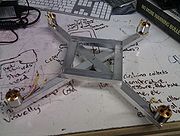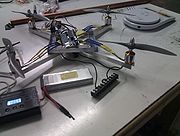Cordova
|
Creator: |
Contents
[hide]Overview
Cordova is the current code name for a two person quadrotorcraft with an estimated lifting capacity of 500lbs. This should be enough power for two people plus some stuff. There will be four rotors, one on each corner of the craft. The seats will be back to back so the two passengers can see everything around them. The rotors will be powered by electric motors, but there will be a diesel generator to provide power to the motors and a backup battery for emergency landings and to maintain flight control in the event of power loss. The choice of diesel is mostly because of energy density when compared to batteries. We don't plan to fly this very high.
Flight Equations
Motors: The cross shape is aligned along the pitch and roll axes. Motors are M1 through M4 with M1 at the front of the aircraft and M2, M3, and M4 arranged clockwise from the front. M1 and M3 spin clockwise while M2 and M4 spin counter clockwise.
Controls consist of a joystick comprising the X and Y input variables. A throttle comprises the Z input variable. A left/right joystick component comprises the yaw input component W. W, X, and Y need modification on input to scale from 0-255 to -128-127.
M1 = Z - W + Y
M2 = Z + W + X
M3 = Z - W - Y
M4 = Z + W - X
Proof of Concept
The PoC will be created using standard model aircraft speed controllers, motors, and propellers. It will be battery powered and have a IMU for stabilization.
Tasks
- Visit RC Hobby Barn
- Return high-friction motor for replacement
- Get new puller blade
- Get decent battery connectors for battery side of battery-to-controller harness
- Purchase secondary battery
- Put proper disconnects on controller side of battery-to-controller harness
- Get sixaxis/laptop interface solidified
- Use larger wires for battery-to-controller harness
- Wait for sparkfun order to come in
- Get xbee communications link working
- Get razor imu working with I2C/UART converter chip
- Write autostabilization code
- Wait for adafruit order to come in
- Build an arduino shield for power input and PWM servo output
History
- 21 Aug 2010 - Cut and assembled frame with rivets
- 30 Aug 2010 - Mounted first motor
- 1 Sept 2010 - Mounted remaining 3 motors and soldered first speed controller
- 7 Sept 2010 - Soldered remaining 3 speed controllers
- 10 Sept 2010 - Spun up first motor, speed controllers work exactly like servos, 50Hz, etc.
- 11 Sept 2010 - Mounted new motors to frame
- 13 Sept 2010
- Shrink wrapped 2 speed controllers for electrical safety
- Created a power bus to hook up multiple motors
- Ran 2 motors simultaneously with a bit of vibration
- It has become obvious that I need better blades that are already balanced and the correct size (instead of milling them out)
- 14 Sept 2010
- Got and tested new 9x6 blades. These should provide more thrust than the 8x4.5 blades and be more durable and balanced.
- Shrink wrapped the remaining speed controller connections.
- Still need 3 loop connectors to connect the speed controllers to power. Getting these tomorrow.
- 15 Sept 2010
- Fixed grounding issues causing pwm to go wonky
- added connectors
- drew blood (thanks ethan, now it has a taste for human flesh)
- produced enough lift to more than compensate for onboard electronics and batteries
- current weight is 2.6lbs including all batteries and electronics
- one motor obviously has more friction than the others causing it to run slower (this needs to be taken care of)
- 16 Sept 2010 - ordered new motor to replace high friction motor
- 17/18 Sept 2010 - figured out how to initialize speed controllers properly
- 20 Sept 2010
- got the new motor in and installed it
- cleaned up the motor mounts so the screws go in cleaner
- ordered the remaining parts required for the control system
- discovered that one of my pull props has a chip out of it from when it tried to eat the table
- 23 Sept 2010 - Received sparkfun order with xbee adapters, IMU, and UART/SPI/I2C converter chip
- 24 Sept 2010
- Received protoboard and long headers from adafruit
Parts Required
- 2 matched blade pairs
- 9"x6 blades from RC hobby barn, $4.96 each
- 4 rc airplane motors
- 950RPM/V, 200W, 18A (max), 10x7 capable motor from RC hobby barn, $20.82 each
- 4 rc airplane speed controllers
- 40A speed controller $16.00 ($64.00) (Purchased)
- Channel aluminum
- 11.1V 3AH LiPo battery from RC hobby barn $29.99
- LiPo battery charger from RC hobby barn $35
- atmel/arduino for motor control ~$30
- User input
- PS3 bluetooth controller
- Telemetry and control
- Xbee $42.95 ($85.90)
- 6mi range
- 50mW
- 900MHz
- Need 2 modules (one for each side)
- usb interface adapter $24.95
- arduino shield adapter $24.95
- Xbee $42.95 ($85.90)
- AHRS: 9DoF with 3DoF Gyro, Accelerometer, and Compass
- Razor IMU $124.95
Stage 1 - Basic Flight
exclusively remote control, direct control input, mixing of controls based on equations above in the microprocessor
Stage 2 - Assisted Manual Flight
Add the IMU to the system.
The atmel will take in raw input channels and mix them according to the equations above like before, but will correct pitch, roll, and overall thrust based on gyro data.
Stage 3 - Automated Stabilization, Hover, and Movement
Add a GPS to the system for location. Real time control via simple instructions.
Instructions:
- Move X meters <direction>
- where direction is one of: up, down, north, south, east, west, (north|south)-(east|west)
- Move to <DD or DMS latitude>,<DD or DMS longitude>[,<altitude in meters>]
Loss of signal results in unit moving back to the location where it powered on unless explicitly told not to.


